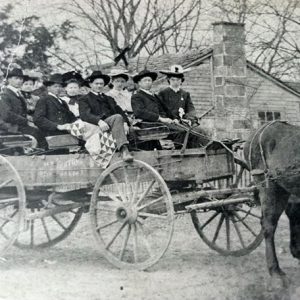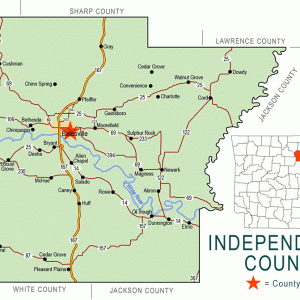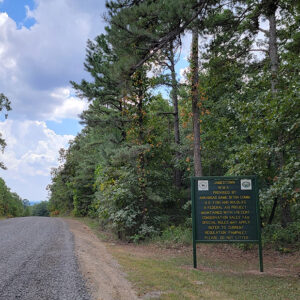calsfoundation@cals.org
Jamestown (Independence County)
Jamestown of Independence County is a small community located approximately eight miles southwest of Batesville (Independence County) at the foot of Jamestown Mountain near Jamestown Creek. During its heyday in the late nineteenth century, it was a thriving area commercial center respected for its educational opportunities.
A settlement began to develop near Jamestown Creek as early as 1844 when Daniel James, an early settler, promoted the area through land speculation. Still, no real town existed until after the Civil War. In 1869, the local Methodist congregation constructed a meeting house that also served as a Masonic hall at what was then called Alderbrook. Because the building was described as “an ornament to the village,” it was decided that a more appropriate name was needed. In an apparent reference to Jamestown, Virginia, it was recorded that Jamestown was chosen because it was an “ancient and honorable name.” It is more likely that the name was chosen to honor Daniel James, who had donated land for the church. In 1880, Jamestown became official with the establishment of a post office. It was incorporated on March 2, 1881.
Soon the area that some described as “picturesque and beautiful” was the site of several large homesteads and a growing community. The first store was opened by J. W. Collins, which soon was followed by a grist mill, a flour mill, a blacksmith, a shoe store, and two dry goods stores, among others. Eventually, two saloons also opened for business. A weekly Democratic newspaper, the Courier, was founded in 1883. While much growth took place in the 1880s, many people, due to its unpaved streets, referred to the community as “Mudtown.”
After the establishment of the Methodist church in 1869, the Presbyterians built a church in 1886. When the Methodist church burned in the 1890s, the Methodists jointly worshiped with the Presbyterians. A Baptist congregation was established in 1888. Each congregation was said to have approximately 125 members.
The town was an important shipping point for area cotton farmers. Dr. M. C. Weaver was a major dealer in the commodity, buying as much as 2,000 bales of cotton each season. Farmers from all around brought their cotton to sell at Jamestown, which would then be hauled by wagon to Batesville.
A boost was experienced when, in 1890, Arkansas Normal College was established as a high school. While the curriculum was designed for the training of school teachers, general degrees were also conferred. At its peak, the school had a larger enrollment than nearby Arkansas College (now Lyon College) in Batesville. The future looked extremely bright for both town and school. However, the educational institution closed around 1901 when the college president was caught selling diplomas through the school correspondence department.
By 1900, the town population had reached 130 citizens. Among the businesses were three general stores, a flour mill, a cotton gin, two blacksmith shops, a hotel, a drugstore, and a photograph studio. After the closing of the school, growth seemed to stagnate, with the population never rising above 126.
Disaster hit the town on August 10, 1921, when a threshing machine was being driven down one of the city streets, throwing sparks to the side. One sparked a fire that burned several houses and approximately two blocks of the business district. The town never recovered, with only a couple of homes being rebuilt. People began to move away, and by the end of the decade, only about 66 people remained.
Today, nothing remains of the once prosperous farming town other than a few residential properties and the 1926 school building, which was placed on the National Register of Historic Places in 1992.
For additional information:
Buchanan, Betty. “Jamestown at Turn of the Century.” Independence County Chronicle 1 (January 1960): 23–28.
Clements, Kathy. “Jamestown Once Boasted a College but Lost It because It Was Giving Unearned Diplomas.” Arkansas Democrat-Gazette, Three Rivers Section, November 22, 2000, p. 6S.
Compton, LaNell. “Life in an Ozark Village.” Arkansas Gazette Magazine, February 15, 1942, pp. 1, 12.
Mike Polston
CALS Encyclopedia of Arkansas
 Engles Descendants
Engles Descendants  Independence County Map
Independence County Map  Entering Jamestown
Entering Jamestown  Jamestown Cemetery
Jamestown Cemetery  Jamestown Church
Jamestown Church  Jamestown Thresher
Jamestown Thresher  Jamestown WMA
Jamestown WMA 




Comments
No comments on this entry yet.